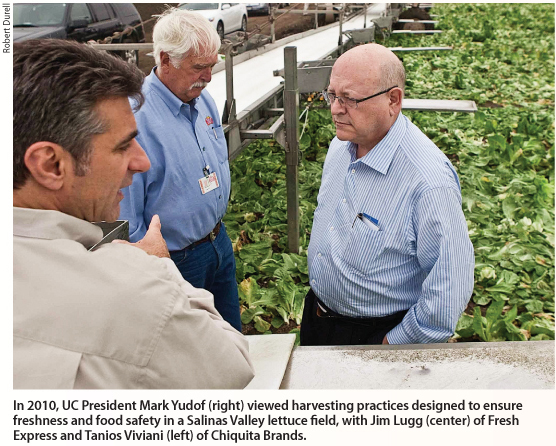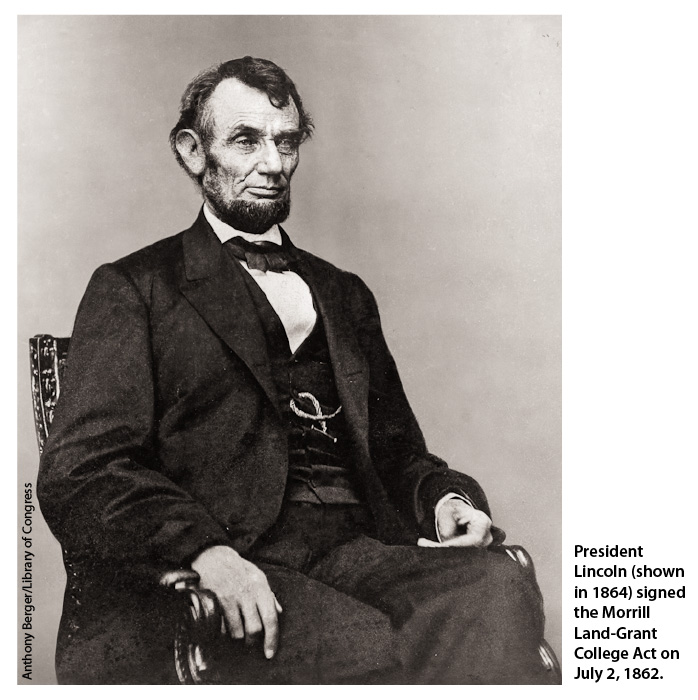All Issues
For 150 years, UC science and agriculture transform California
Publication Information
California Agriculture 66(2):40-41.
Published online April 01, 2012
PDF | Citation | Permissions
Full text
Growing up in West Philadelphia, the son of an electrician, I never had much occasion to encounter farm life. Our meat and potatoes came from the grocery store and our vegetables from the frozen food aisle. So one of the great privileges I have enjoyed as president of the University of California is learning about my adopted state's diverse agriculture industry and the amazing bounty it produces.
Having previously served as president of another land-grant college system, the University of Minnesota, I was no stranger to agriculture when I moved here in 2008. But I quickly found that nothing compares to California's agricultural legacy and the forward-thinking leadership of its farmers and ranchers. As UC president I meet regularly with the Advisory Commission on Agriculture and Natural Resources. I have had the opportunity to visit Central Valley farming communities, taste-test a new UC Davis olive oil blend, learn more about almond-growing than any of my city friends could imagine and even get a lesson in lettuce harvesting in the Salinas Valley.
As I have traveled through the state on these eye-opening excursions, I have been reminded many times of the critical contribution agriculture makes to the California economy and the prominent role our university plays in that industry. Whether you're a backyard gardener, a 4-H student, a small family farmer or a major national food producer, chances are what you raise has in some way benefitted from UC innovation and collaboration.
In 2010, UC President Mark Yudof (right) viewed harvesting practices designed to ensure freshness and food safety in a Salinas Valley lettuce field, with Jim Lugg (center) of Fresh Express and Tanios Viviani (left) of Chiquita Brands.
To name just a few examples, about 40% of the strawberries grown in the world come from UC-developed varieties.
UC Davis certifies 95% of the grapevines sold in California, providing our wine industry with a reliable supply of vines. I have even learned that canned fruit cocktail originated at UC when in the 1930s food science pioneer William Vere Cruess came up with a way to keep fruit from going to waste.
Long-standing partnership
From the hundreds of varieties of crops developed to methods of cultivation, irrigation, animal husbandry, pest control, processing and packaging — it is evident that the agriculture industry's long partnership with the university has been a profitable and mutually beneficial one.
Indeed, I would go as far as to say that UC might not have evolved into the world's greatest public university system nor would California agriculture have grown into the $37.5 billion industry it is today if we hadn't teamed up nearly 150 years ago.
The catalyst for that partnership was, of course, the Morrill Land-Grant College Act, signed into law by Abraham Lincoln on July 2, 1862. This issue of California Agriculture celebrates the 150th anniversary of that landmark legislation in recognition of the impact it had on the future of California, our university and our nation (see pages 42 – 49 ).
It was the early days of the Civil War when Lincoln signed the law introduced by Vermont Congressman Justin Smith Morrill. The law granted federal land for states to fund colleges teaching agriculture and “the mechanic arts.” At the time, our country was being split apart, yet Lincoln had the foresight to envision a future of peace and prosperity in a nation united and populated by an educated citizenry.
Farmers' legislation
The Morrill Act was part of a slate of so-called “farmers' legislation” Lincoln signed that year. Included were the laws that created the U.S. Department of Agriculture and the Homestead Act, which granted plots of land in the West for settlers to farm. He also signed the Pacific Railway Act, which cleared the way to build the transcontinental rail-road. You can debate the politics that influenced the creation of these laws and some of the unintended consequences, but there is no question they collectively transformed our country.
With trains connecting East and West, settlers could travel with relative ease to the Western frontier. They could also transport the products of their farming endeavors to markets across the continent.
The railroad opened access to California's fertile valleys, teeming rivers and rich natural resources for a new crop of pioneer families. The Morrill Act opened access to learning for their children and for future generations who might otherwise never have had the opportunity to earn an education.
The nationwide university access the Morrill Act provided was certainly a game-changer in social mobility and economic prosperity. Just as important was the Act's intention to apply scientific research to farming methods and resource stewardship.
Science and agriculture
UC embraced those intentions with a deep and passionate commitment. From humble beginnings at the campus in Berkeley, the University Farm at Davis and the Citrus Experiment Station at Riverside, UC dedicated its resources and knowledge to improving the quality of life and health of all Californians. Nowhere is that dedication so evident as in the mission of the university's Division of Agriculture and Natural Resources. Working side-by-side with California farmers, thousands of UC researchers and educators toil every day to solve the problems of modern agriculture and resource preservation.
The challenges we face together today are far more complex than those California farmers faced in the 19th century. Today we deal with issues like climate change, exotic invasive pests, food security, nutrition and childhood obesity, to name a few. But no matter how daunting the challenges might seem, UC is on the ground in every county — advising, educating and searching for solutions. True to the Morrill Act's philosophy of melding science and agriculture, UC brings to the table the most visionary, industry-transformative research methods.
In just this one issue of California Agriculture, you will find several examples of how UC research works for our state's producers.
One article details the impressive yield increases for corn and tomatoes achieved during an 11-year field study of conservation tillage (see page 55 ). This cultivation method, which forgoes tilling and leaves residue from the previous crop on the ground, has the potential to reduce soil water evaporation losses in summer by about 4 inches, or 13%.
Eugene W. Hilgard, a German-American soil scientist, became professor and director of the Agricultural Experiment Station in 1875. During his 30-year tenure, Hilgard established UC as a respected center of agricultural research and guided the college to transfer knowledge statewide via field stations and farmer institutes. Hilgard Hall, dedicated in 1917, currently houses the College of Natural Resources at UC Berkeley.
You can read about why dry matter and fruit acidity should be considered as a quality index for kiwifruit (see page 70 ), while another article analyzes recent trends in genetic engineering of fruit and nut trees, and suggests that transgrafting may be a promising approach for utilizing biotechnology to address both grower and consumer needs (see page 62 ).
This is the type of research that ultimately benefits every consumer by increasing the variety and quality of food, keeping supermarket prices down, meeting environmental challenges, promoting nutrition and food safety and contributing to the productivity of one of the state's most important economic engines. Of course, California agriculture has impacts far beyond the borders of our state: The whole world depends on the bounty of California's fields and orchards. UC is proud to contribute the scientific and technological expertise that helped the state's producers become world leaders in the global marketplace.
Despite the budget challenges the university has faced in recent years, our commitment to a healthy and sustainable California agriculture industry is as strong as ever. That partnership we forged nearly a century and a half ago is truly a fundamental cornerstone of California society. We at the university, through the leadership of ANR, look forward to building upon it for many years to come.








